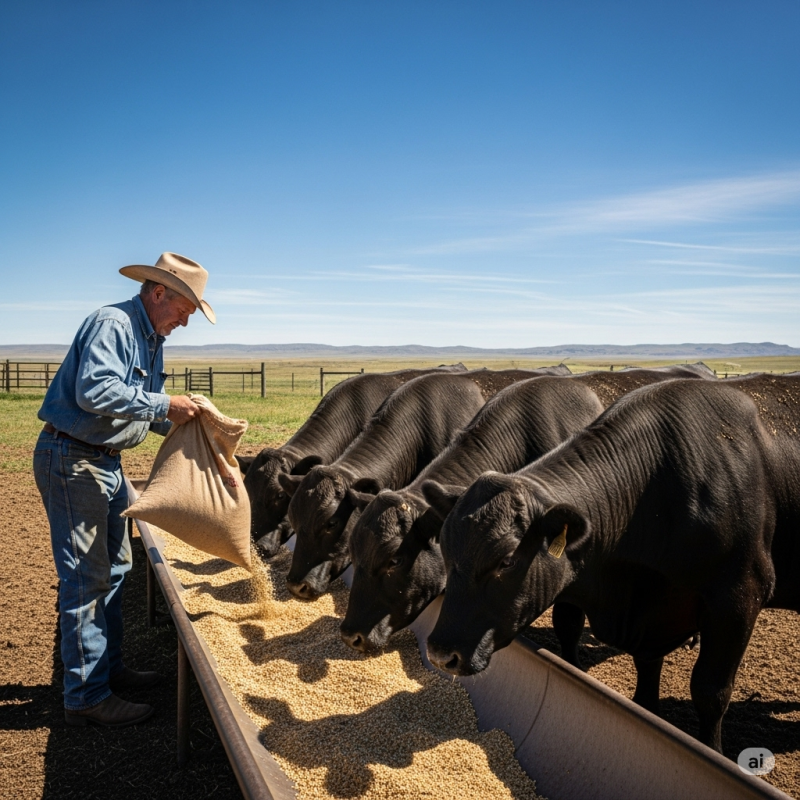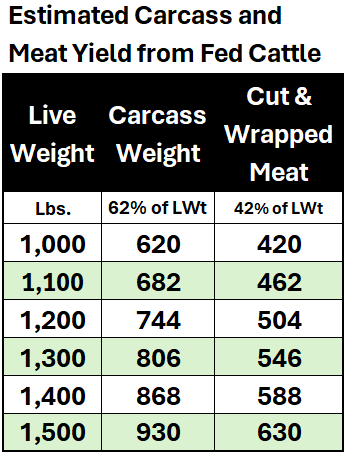Mark Z. Johnson, Oklahoma State University Extension Beef Cattle Breeding Specialist

As a general guideline, expect to take home about 42 percent of the live weight of a finished steer for consumption. Credit Graphic generated using Google Gemini AI
Cattle producers who finish their own calves or consumers who purchase a finished steer often face the question, “How much beef they will take home after the harvest and cutting process?” The answer to the question dictates how much freezer space will be needed. The amount of product yielded from a finished beef calf is often misunderstood. Accordingly, this article addresses what to expect in terms of the relationship between live weight, carcass weight, and actual take home product from fed cattle.
Dressing Percentage (DP) is the portion of the live weight that will result in hot carcass weight (HCW) after removal of the head, hide and internal organs. For most fed cattle, the HCW will range from 60 – 64%. HCW will vary and is influenced by gut fill, degree of muscularity and fatness, mud or manure on the hide, and pregnancy status. For example, a 1500 live finished beef calf with a dressing percentage of 62% DP would yield a 930 pound carcass. The 930 pound HCW is not the amount of beef the consumer will take home to put in the freezer. It is noteworthy that the chilled carcass weight will shink 2 – 5 percent lower than HCW. A beef carcass is 70 – 75 percent water, as it chills water evaporation further reduces the total carcass weight.
–
Chilled Carcass Weight, Primals, Sub-Primals and Retail Cuts
After the carcass is cooled, it will be further processed into cuts of meat. This process is referred to as “breaking down the carcass.” Beef primal cuts are the rib, chuck, shank, brisket, plate, flank, round, short loin, and sirloin. Primal cuts will be further processed into sub-primal or retail cuts. The basic concept is to remove the majority of the bones, separate tender muscles from less tender muscles, separate thicker muscles from thin muscles, and to separate fatter from leaner portions. There are several factors that will influence the amount of beef that will be cut and wrapped for the freezer. The most common factors influencing variation include:
External Carcass Fat has the greatest impact on the percentage of retail product from a carcass. As more fat is trimmed away, less weight will be in the packaged meat.
Superior Carcass Muscularity will increase the percentage of retail product. For example, Dairy-type cattle typically yield lower than beef-type cattle.

Source: How Much Meat to Expect from a Beef Carcass, University of Tennessee
Cutting Style or the cutting specs given to the processor can effect the take home yield as well. This can be a major influence based on the amount of bone-in versus boneless cuts, how much external fat is trimmed off, and the amount of fat in the ground beef.
Carcass Aging (typically for 10 – 14 days) offers the advantages of improving tenderness and intensifying the flavor of beef. With respect to carcass yield, long-term aging can have a negative effect.
–
Bottom-line
As a general guideline, expect to take home ~42% of the live weight for consumption. If basing the prediction off HCW, expect to take home roughly two-thirds. Using the 1,500 pound live fed steer with a 62% DP referenced in the above example, you will need freezer storage space for about 630 pounds of cut and wrapped beef. More detailed information is available in the material referenced below.
–
References:
–
How Much Meat to Expect from a Beef Carcass (University of Tennessee)
–
Custom Beef Processing: Expected Yields (Oklahoma State University)
- Federal Estate Tax and Gift Tax Limits Announced For 2026 - December 19, 2025
- Why Do I Have So Many Open Cows? Causes of Reproductive Failure - December 19, 2025
- Wiregrass Cotton Expo Offers Resources, Research, & Real Solutions for Growers in Southeast – January 22 - December 19, 2025
